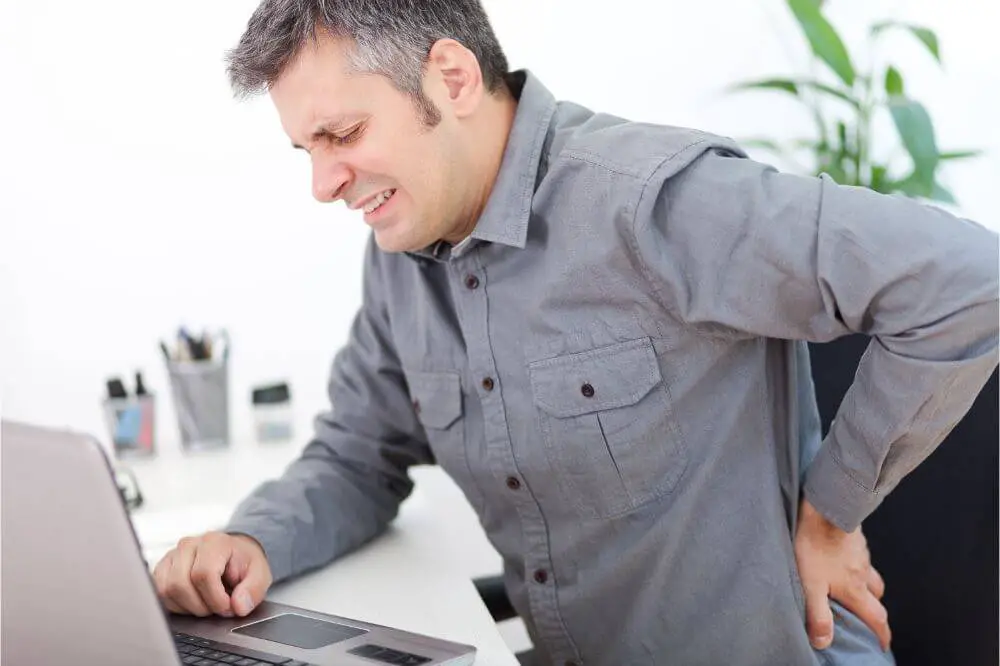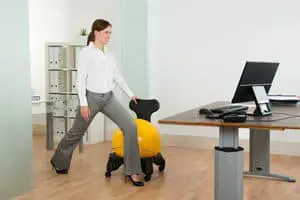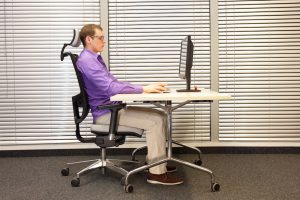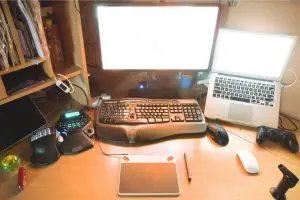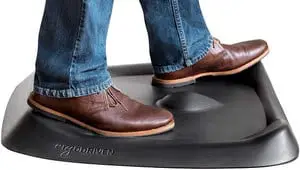Did you know that four out of five adults experience lower back or hip pain at one point? Dealing with lower back or hip pain can be a pain in the butt, literally and figuratively, especially when you have to sit at work. It’s not going to take long before the aches and discomfort kick you in the behind.
But wait, are these two problems the same, or are they two different? Before learning how to sit with lower back or hip pain, it’s essential to understand their differences. By doing your part to assess the symptoms, you are helping your body heal while staying productive at home and in the office.
All content and media on Office Solution Pro are created and published online for informational purposes only. It is not intended as a substitute for professional medical advice and should not be relied on as health or personal advice. This post may contain affiliate links.
Difference Between Hip Pain and Back Pain
Back pain can seem like hip flexor pain because there are a lot of similarities, says hip specialist Trevor Murray, MD. from the Cleveland Clinic. This is because most hip and back problems happen due to natural wear and tear of the body.
According to Dr. Dharmesh Vyas, MD, Ph.D., an orthopedic surgeon, he states, “While these conditions (hip pain and back pain) are common, due to the anatomy of the hip, patients often mistake hip pain for what is actually back pain.”
So, how can we differentiate between the two? The first thing you need to do is to see your doctor or physician and get the correct diagnosis. However, there are some telltale signs that can help you pinpoint the source of pain.
Symptoms of Hip Pain
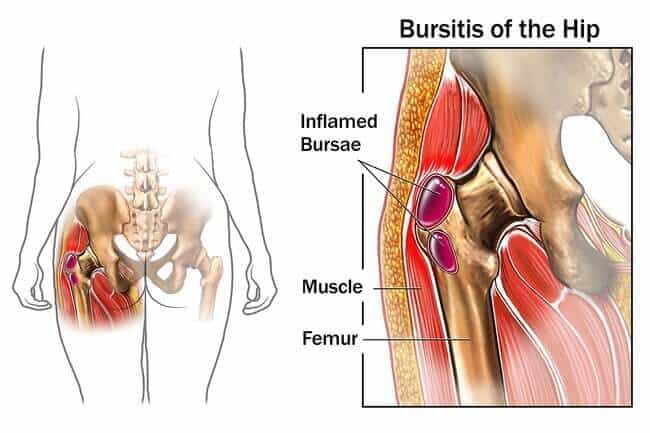
Image sourced from webmd.com
Hip issues usually cause groin pain on the affected side. Russell DeMicco, DO. states that “Groin pain is a hip issue until proven otherwise. Pain above the beltline is not a hip issue.” You may feel these symptoms when experiencing hip pain:
- Pain in the groin area
- Pain comes and goes
- Pain becomes worse with walking and activity
- Pain becomes better with rest
- You walk with a limp
Symptoms of Lower Back Pain
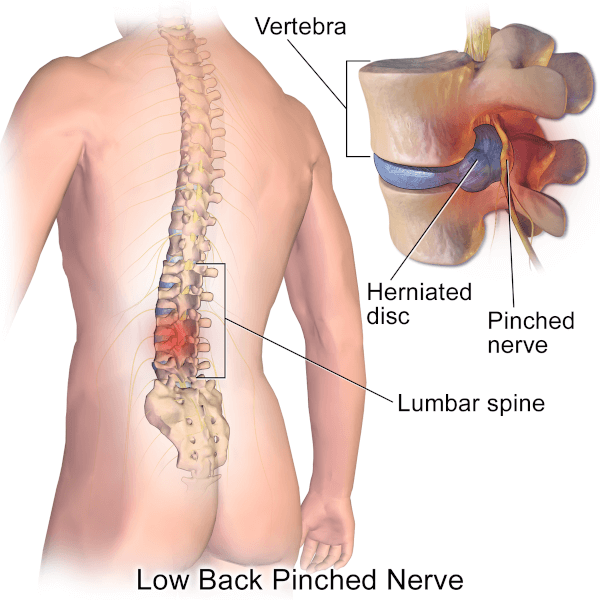
Image sourced from afcchiropractic.com
Lower back or spine problems produce pain in the hips, commonly known as sciatica. The pinching of the sciatic nerve causes most lower back pain. Because this long nerve runs through the legs, you may feel discomfort in your buttocks and the backside of the thigh. You may have a spine problem when you experience the following:
- Pain in the lower back
- Pain in the backside of the thigh, sometimes down your leg
- Pain becomes worse when sitting or bending
- Pain becomes better when standing or walking
Another common cause for most lower back problems is a herniated disc. Often, a herniated disc is more painful when sitting and relieved by standing or walking. However, to assess the symptoms properly, it’s best to consult a doctor or physician, which brings us to…
Get Proper Diagnosis
A thorough physical examination is a good place to start when sorting out symptoms. It is possible to experience mild discomfort, only to find large damage through the x-rays. Therefore, getting an accurate diagnosis is important to treat your problem once and for all.
Whether you have back pain or hip flexor pain, dealing with either of them can be troublesome when working, especially when you are required to sit for a living. Now that we’ve gone through the differences, let’s go over some of the things you can do to find comfort while sitting down.
Best Way to Sit with Lower Back or Hip Pain
1. Getting Proper Sleep the Night Before
Allowing your body to rest the night before a full day of work is one of the best things you can do to help reduce the discomfort the next day. However, you’re probably having trouble finding comfort on the bed and have tried multiple sleeping positions, only to struggle to sleep because the pain is too much to bear.
According to rehabilitation expert Peter Fricker, the two best sleeping positions for lower back pain and hip pain are: Number one is to sleep on your back with both legs spread apart. Number two is to sleep on the unaffected side of the body with a pillow between the knees.
You can try either of these two positions to get some well-deserved rest the night before work. According to Peter Fricker, implementing the best sleep position for lower back pain will help “reduce the possibility of re-injury to the hip joint.”
2. Learn How to Sit with Good Posture
As with sleeping, you probably know which sitting positions cause you pain. But do you know the best sitting position for lower back or hip pain? According to the Cleveland Clinic, the key to recovering from lower back or hip pain is maintaining the normal curve of the spine.
That said, proper sitting posture will make a difference in the aches and pain you have in your body, particularly in your lower back. Here is a detailed guide from physical therapists Bob Schrupp and Brad Heineck to help you understand good sitting posture:
Sit in a well-designed ergonomic office chair instead of a regular one. The best computer chairs are built with proper cushioning to support your lumbar spine. Not only will ergonomic chairs provide comfort, but they also promote alignment of your body to ensure healthy blood circulation.
If you work in a communal office and cannot change the furniture, you can buy a reliable lumbar cushion to help support your lower back. Doing so will help maintain a neutral posture throughout the day without much effort. Remember not to sit in one position for more than 20 minutes at a time.
3. Wear Hip Compression
Hip compression can be an effective tool to help combat hip and lower back pain. These hip braces increase blood flow and reduce recovery time by providing a soothing compression to relieve the overall pain.
If you are considering buying a hip brace, make sure to buy compression made with neoprene, as it keeps you cool and comfortable in most circumstances. You don’t have to worry about looking silly at the office as you can wear them under your clothes.
4. Walk and Exercise Daily
Staying inactive for long periods of time can be detrimental to your overall well-being. Remember, one of the leading causes of lower-body injuries is because of weak muscles and joints. When you sit around all day, not only do your muscles become underdeveloped, but it may constrict blood flow to the lower region of the body.
It’s a good idea to stretch every once in a while during the day. If you work at the office, take a few minutes to walk around. Something as simple as taking a glass of water or greeting your office buddy can make a lot of difference in your overall productivity.
5. Apply Ice or Heat
Your hip or lower back pain may happen because of inflammation. Applying cold ice can help reduce the swelling affecting your lower spine. You can place an ice pack for about 15 minutes once every hour of sitting.
If the inflammation is under control, usually the day after, you may use heat to soothe the aches. Not only does heat provide soothing relief, but it helps with promoting healthy blood circulation in your lower back.
For those working in the office, another alternative is to apply a topical cream or heat patches while sitting at work. It’s a quick and easy way to alleviate the discomfort. Just be sure to follow the instructions on the package appropriately.
PRO TIP: Having stronger hip flexors is paramount in combating lower back pain. One of the best exercises for lower back pain and strengthening the hip flexors is the glute bridge. Doing this simple exercise daily will help create a stronger lower body.
Related Questions to Lower Back and Hip Pain
1. How do I know if my back pain is serious?
Most back pain improves gradually with home treatment and self-care. However, if your lower back pain does not improve within 1 or 2 weeks, you should visit your doctor. Getting an accurate diagnosis is paramount to getting the right treatment plan.
While each case of back pain is unique, the symptoms below can help you determine if your lower back pain is severe:
- Bowel or bladder problems
- High fever
- The pain extends below the knee
- Doesn’t improve with rest
- Unexplained weight loss
2. Can stress cause back pain?
Yes, emotional stress may cause back pain. Nonetheless, there are a variety of theories about the causes of stress-related back pain. Everything comes back to how a person reacts naturally to stress. Some may manifest stress in their minds, while others manifest it physically.
According to The Physio Company, muscles in the body can tighten whenever stress manifests physically. The most common area of tension happens in the shoulders and down the spine, which may trigger the person’s pain or discomfort.
With that said, it’s important not to overwork yourself to the point of emotional distress. Remember to take a break from work every now and then to focus on your overall well-being. Maybe, a few days of vacation from work is just what the doctor ordered.
3. Can dehydration cause lower back pain?
Yes, dehydration may cause lower back pain. Hydration, or lack thereof, is a surprising factor that impacts your spine. According to the Spine Institute of North America, movements like jumping, running, walking, and bending all take away some of the fluid in the spinal discs.
These spinal discs are the shock absorbers that keep your bones from rubbing together. Nonetheless, they cannot do their job unless they’re fully hydrated. Because the cushioning ability of your discs is based on their water content, dehydration may lead to spine degeneration and lower back pain.
Considering everything, it’s important to stay hydrated and drink a minimum of 8 glasses of water per day. Not only will staying hydrated keep your back healthy, but it will boost your overall productivity by keeping your brain shooting on all cylinders.
4. How long does a lower back strain take to heal?
According to Shoreline Orthopaedics, back muscle strains can heal within a few days up to a few weeks, typically between 3 to 4 weeks. While these symptoms typically heal with time, it’s best to refrain from vigorous activities too quickly as it may cause re-injury, which can be worse than the initial injury.
The best thing to always remember is that staying consistent with physical therapy is the key to solving the problem once and for all. Be sure to listen to your doctor or physician for the best outcome. At the end of the day, your health is your number one priority.
PRO TIP: If you suffer from lower back and hip pain but need to sit during work, consider reading our comprehensive reviews of the best office chairs for lower back pain. Our team underwent countless hours of research and testing to find the best options for you to avoid lower back pain. You’ll definitely find the right chair.
Bottom Line
While learning how to sit with lower back or hip pain can help you get through the day, it’s essential to see your doctor or physical therapist to get an accurate diagnosis. The proper treatment plan can be the difference between constant pain and permanent relief.
In addition to understanding the best way to sit with lower back or hip pain, exercising daily can help your cause in fighting the negative effects of a sedentary lifestyle. At the end of the day, becoming active is the best way to live a fulfilling life. 🙂
